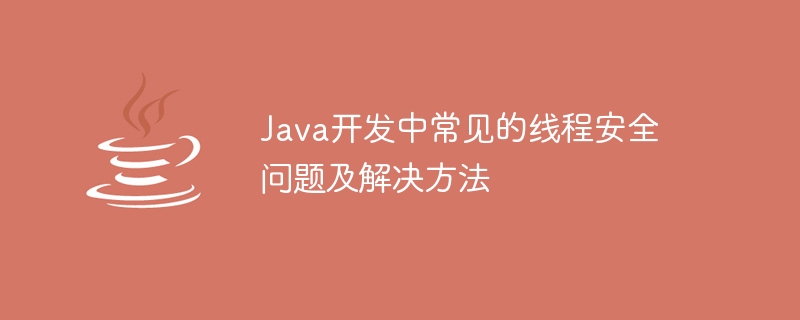Java開發中常見的執行緒安全性問題及解決方法

Java開發中常見的執行緒安全性問題及解決方法
在Java開發中,多執行緒是一個非常常見且重要的概念。然而,多執行緒也往往會帶來一系列的線程安全問題。線程安全性問題指的是多個執行緒同時存取共享資源時可能會出現的資料錯誤、邏輯錯誤等問題。本文將介紹一些常見的線程安全性問題,並提供相應的解決方法,同時附上程式碼範例。
- 競態條件(Race Condition)
競態條件是指多個執行緒同時存取並修改共享資源,導致資源的最終結果與期望不符的問題。常見的競態條件問題包括計數器遞增、資料讀寫等。
解決方法一:使用synchronized關鍵字
透過在關鍵程式碼段上使用synchronized關鍵字,可以保證同一時間只有一個執行緒可以執行該程式碼段,從而避免競態條件問題。
程式碼範例:
class Counter {
private int count = 0;
public synchronized void increment() {
count++;
}
public int getCount() {
return count;
}
}解決方法二:使用Lock介面
使用Lock介面可以提供更細粒度的鎖定,與synchronized相比,Lock介面更靈活。
程式碼範例:
import java.util.concurrent.locks.Lock;
import java.util.concurrent.locks.ReentrantLock;
class Counter {
private int count = 0;
private Lock lock = new ReentrantLock();
public void increment() {
lock.lock();
try {
count++;
} finally {
lock.unlock();
}
}
public int getCount() {
return count;
}
}- 死鎖(Deadlock)
死鎖是指多個執行緒互相等待對方釋放資源,導致程式無法繼續執行的問題。
預防死鎖的方法主要有兩種:
一是避免循環依賴;
二是使用線程池(ThreadPoolExecutor)代替單獨建立線程,線程池可以有效管理線程的生命週期,防止死鎖。
程式碼範例:
import java.util.concurrent.ExecutorService;
import java.util.concurrent.Executors;
class Resource {
private final Object lock1 = new Object();
private final Object lock2 = new Object();
public void methodA() {
synchronized (lock1) {
synchronized (lock2) {
// do something
}
}
}
public void methodB() {
synchronized (lock2) {
synchronized (lock1) {
// do something
}
}
}
}
public class Main {
public static void main(String[] args) {
ExecutorService executorService = Executors.newFixedThreadPool(2);
Resource resource = new Resource();
executorService.submit(() -> resource.methodA());
executorService.submit(() -> resource.methodB());
executorService.shutdown();
}
}- 執行緒間通訊問題
執行緒間通訊問題主要指的是一個執行緒等待另一個執行緒的操作結果,常見的場景包括生產者-消費者問題、執行緒池任務回傳值等。
解決方法:使用wait()和notify()方法來搭配使用
wait()方法可以讓目前執行緒等待,而notify()方法可以喚醒一個等待的執行緒。
程式碼範例:
class SharedResource {
private int value;
private boolean isValueSet = false;
public synchronized void setValue(int value) {
while (isValueSet) {
try {
wait();
} catch (InterruptedException e) {
e.printStackTrace();
}
}
this.value = value;
isValueSet = true;
notify();
}
public synchronized int getValue() {
while (!isValueSet) {
try {
wait();
} catch (InterruptedException e) {
e.printStackTrace();
}
}
isValueSet = false;
notify();
return value;
}
}
public class Main {
public static void main(String[] args) {
SharedResource sharedResource = new SharedResource();
Thread producer = new Thread(() -> {
for (int i = 0; i < 10; i++) {
sharedResource.setValue(i);
System.out.println("Producer produces: " + i);
try {
Thread.sleep(1000);
} catch (InterruptedException e) {
e.printStackTrace();
}
}
});
Thread consumer = new Thread(() -> {
for (int i = 0; i < 10; i++) {
int value = sharedResource.getValue();
System.out.println("Consumer consumes: " + value);
try {
Thread.sleep(1000);
} catch (InterruptedException e) {
e.printStackTrace();
}
}
});
producer.start();
consumer.start();
}
}在Java開發中,執行緒安全性問題是一個需要特別注意的問題。透過了解常見的線程安全性問題以及相應的解決方法,我們可以更好地編寫線程安全的程式碼,提高程式的品質和可靠性。
以上是Java開發中常見的執行緒安全性問題及解決方法的詳細內容。更多資訊請關注PHP中文網其他相關文章!

熱AI工具

Undresser.AI Undress
人工智慧驅動的應用程序,用於創建逼真的裸體照片

AI Clothes Remover
用於從照片中去除衣服的線上人工智慧工具。

Undress AI Tool
免費脫衣圖片

Clothoff.io
AI脫衣器

Video Face Swap
使用我們完全免費的人工智慧換臉工具,輕鬆在任何影片中換臉!

熱門文章

熱工具

記事本++7.3.1
好用且免費的程式碼編輯器

SublimeText3漢化版
中文版,非常好用

禪工作室 13.0.1
強大的PHP整合開發環境

Dreamweaver CS6
視覺化網頁開發工具

SublimeText3 Mac版
神級程式碼編輯軟體(SublimeText3)
 公司安全軟件導致應用無法運行?如何排查和解決?
Apr 19, 2025 pm 04:51 PM
公司安全軟件導致應用無法運行?如何排查和解決?
Apr 19, 2025 pm 04:51 PM
公司安全軟件導致部分應用無法正常運行的排查與解決方法許多公司為了保障內部網絡安全,會部署安全軟件。 ...
 centos minio安裝權限問題
Apr 14, 2025 pm 02:00 PM
centos minio安裝權限問題
Apr 14, 2025 pm 02:00 PM
CentOS系統下MinIO安裝的權限問題及解決方案在CentOS環境部署MinIO時,權限問題是常見難題。本文將介紹幾種常見的權限問題及其解決方法,助您順利完成MinIO安裝與配置。修改默認賬戶及密碼:您可以通過設置環境變量MINIO_ROOT_USER和MINIO_ROOT_PASSWORD來修改默認的用戶名和密碼。修改後,重啟MinIO服務即可生效。配置存儲桶訪問權限:將存儲桶設置為公開(public)會導致目錄可被遍歷,存在安全風險。建議自定義存儲桶訪問策略。您可以通過MinIO
 PHP如何使用phpMyadmin創建Mysql數據庫
Apr 10, 2025 pm 10:48 PM
PHP如何使用phpMyadmin創建Mysql數據庫
Apr 10, 2025 pm 10:48 PM
phpMyAdmin 可用於在 PHP 項目中創建數據庫。具體步驟如下:登錄 phpMyAdmin,點擊“新建”按鈕。輸入要創建的數據庫的名稱,注意符合 MySQL 命名規則。設置字符集,如 UTF-8,以避免亂碼問題。
 Navicat 無法連接數據庫的解決方法
Apr 08, 2025 pm 11:12 PM
Navicat 無法連接數據庫的解決方法
Apr 08, 2025 pm 11:12 PM
可以通過以下步驟解決 Navicat 無法連接數據庫的問題:檢查服務器連接,確保服務器運行、地址和端口正確,防火牆允許連接。驗證登錄信息,確認用戶名、密碼和權限正確。檢查網絡連接,排除網絡問題,例如路由器或防火牆故障。禁用 SSL 連接,某些服務器可能不支持。檢查數據庫版本,確保 Navicat 版本與目標數據庫兼容。調整連接超時,對於遠程或較慢的連接,增加連接超時時間。其他解決方法,如果上述步驟無效,可以嘗試重新啟動軟件,使用不同的連接驅動程序,或諮詢數據庫管理員或 Navicat 官方支持。
 Redis內存使用率過高怎麼辦?
Apr 10, 2025 pm 02:21 PM
Redis內存使用率過高怎麼辦?
Apr 10, 2025 pm 02:21 PM
Redis內存飆升的原因包括:數據量過大、數據結構選擇不當、配置問題(如maxmemory設置過小)、內存洩漏。解決方法有:刪除過期數據、使用壓縮技術、選擇合適的結構、調整配置參數、檢查代碼是否存在內存洩漏、定期監控內存使用情況。
 CentOS HDFS配置有哪些常見誤區
Apr 14, 2025 pm 07:12 PM
CentOS HDFS配置有哪些常見誤區
Apr 14, 2025 pm 07:12 PM
CentOS下Hadoop分佈式文件系統(HDFS)配置常見問題及解決方案在CentOS系統上搭建HadoopHDFS集群時,一些常見的錯誤配置可能導致性能下降、數據丟失甚至集群無法啟動。本文總結了這些常見問題及其解決方法,幫助您避免這些陷阱,確保HDFS集群的穩定性和高效運行。機架感知配置錯誤:問題:未正確配置機架感知信息,導致數據塊副本分佈不均,增加網絡負載。解決方案:仔細檢查hdfs-site.xml文件中的機架感知配置,並使用hdfsdfsadmin-printTopo
 vs code 可以在 Windows 8 中運行嗎
Apr 15, 2025 pm 07:24 PM
vs code 可以在 Windows 8 中運行嗎
Apr 15, 2025 pm 07:24 PM
VS Code可以在Windows 8上運行,但體驗可能不佳。首先確保系統已更新到最新補丁,然後下載與系統架構匹配的VS Code安裝包,按照提示安裝。安裝後,注意某些擴展程序可能與Windows 8不兼容,需要尋找替代擴展或在虛擬機中使用更新的Windows系統。安裝必要的擴展,檢查是否正常工作。儘管VS Code在Windows 8上可行,但建議升級到更新的Windows系統以獲得更好的開發體驗和安全保障。
 visual studio code 可以用於 python 嗎
Apr 15, 2025 pm 08:18 PM
visual studio code 可以用於 python 嗎
Apr 15, 2025 pm 08:18 PM
VS Code 可用於編寫 Python,並提供許多功能,使其成為開發 Python 應用程序的理想工具。它允許用戶:安裝 Python 擴展,以獲得代碼補全、語法高亮和調試等功能。使用調試器逐步跟踪代碼,查找和修復錯誤。集成 Git,進行版本控制。使用代碼格式化工具,保持代碼一致性。使用 Linting 工具,提前發現潛在問題。






